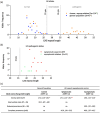An exploration of the genetics of the mutant Huntingtin (mHtt) gene in a cohort of patients with chorea from different ethnic groups in sub-Saharan Africa
- PMID: 38563088
- PMCID: PMC12152512
- DOI: 10.1111/ahg.12557
An exploration of the genetics of the mutant Huntingtin (mHtt) gene in a cohort of patients with chorea from different ethnic groups in sub-Saharan Africa
Abstract
Background: Africans are underrepresented in Huntington's disease (HD) research. A European ancestor was postulated to have introduced the mutant Huntingtin (mHtt) gene to the continent; however, recent work has shown the existence of a unique Htt haplotype in South-Africa specific to indigenous Africans.
Objective: We aimed to investigate the CAG trinucleotide repeats expansion in the Htt gene in a geographically diverse cohort of patients with chorea and unaffected controls from sub-Saharan Africa.
Methods: We evaluated 99 participants: 43 patients with chorea, 21 asymptomatic first-degree relatives of subjects with chorea, and 35 healthy controls for the presence of the mHtt. Participants were recruited from 5 African countries. Additional data were collected from patients positive for the mHtt gene; these included demographics, the presence of psychiatric and (or) cognitive symptoms, family history, spoken languages, and ethnic origin. Additionally, their pedigrees were examined to estimate the number of people at risk of developing HD and to trace back the earliest account of the disease in each region.
Results: HD cases were identified in all countries. Overall, 53.4% of patients with chorea were carriers for the mHTT; median tract size was 45 CAG repeats. Of the asymptomatic relatives, 28.6% (6/21) were carriers for the mHTT; median tract size was 40 CAG. No homozygous carries were identified. Median CAG tract size in controls was 17 CAG repeats. Men and women were equally affected by HD. All patients with HD-bar three who were juvenile onset of <21 years-were defined as adult onset (median age of onset was 40 years). HD transmission followed an autosomal dominant pattern in 84.2% (16/19) of HD families. In familial cases, maternal transmission was higher 52.6% (10/19) than paternal transmission 36.8% (7/19). The number of asymptomatic individuals at risk of developing HD was estimated at ten times more than the symptomatic patients. HD could be traced back to the early 1900s in most African sites. HD cases spread over seven ethnic groups belonging to two distinct linguistic lineages separated from each other approximately 54-16 kya ago: Nilo-Sahara and Niger-Congo.
Conclusion: This is the first study examining HD in multiple sites in sub-Saharan Africa. We demonstrated that HD is found in multiple ethnic groups residing in five sub-Saharan African countries including the first genetically confirmed HD cases from Guinea and Kenya. The prevalence of HD in the African continent, its associated socio-economic impact, and genetic origins need further exploration and reappraisal.
Keywords: Huntington disease; Niger‐Congo; mHTT; sub‐Saharan African origin.
© 2024 The Authors. Annals of Human Genetics published by University College London (UCL) and John Wiley & Sons Ltd.
Conflict of interest statement
The authors declare no conflicts of interest.
Figures


Similar articles
-
Junctophilin 3 (JPH3) expansion mutations causing Huntington disease like 2 (HDL2) are common in South African patients with African ancestry and a Huntington disease phenotype.Am J Med Genet B Neuropsychiatr Genet. 2015 Oct;168(7):573-85. doi: 10.1002/ajmg.b.32332. Epub 2015 Jun 16. Am J Med Genet B Neuropsychiatr Genet. 2015. PMID: 26079385 Free PMC article.
-
Huntington disease in the South African population occurs on diverse and ethnically distinct genetic haplotypes.Eur J Hum Genet. 2013 Oct;21(10):1120-7. doi: 10.1038/ejhg.2013.2. Epub 2013 Mar 6. Eur J Hum Genet. 2013. PMID: 23463025 Free PMC article.
-
Tracing the mutated HTT and haplotype of the African ancestor who spread Huntington disease into the Middle East.Genet Med. 2020 Nov;22(11):1903-1908. doi: 10.1038/s41436-020-0895-1. Epub 2020 Jul 14. Genet Med. 2020. PMID: 32661355
-
[From gene to disease; HD gene and Huntington disease].Ned Tijdschr Geneeskd. 2001 Nov 3;145(44):2120-3. Ned Tijdschr Geneeskd. 2001. PMID: 11723754 Review. Dutch.
-
[Differential diagnosis of chorea].Brain Nerve. 2009 Aug;61(8):963-71. Brain Nerve. 2009. PMID: 19697886 Review. Japanese.
Cited by
-
Increased frequency of repeat expansion mutations across different populations.medRxiv [Preprint]. 2024 Jul 8:2023.07.03.23292162. doi: 10.1101/2023.07.03.23292162. medRxiv. 2024. Update in: Nat Med. 2024 Nov;30(11):3357-3368. doi: 10.1038/s41591-024-03190-5. PMID: 37461547 Free PMC article. Updated. Preprint.
-
Increased frequency of repeat expansion mutations across different populations.Nat Med. 2024 Nov;30(11):3357-3368. doi: 10.1038/s41591-024-03190-5. Epub 2024 Oct 1. Nat Med. 2024. PMID: 39354197 Free PMC article.
References
-
- Baine, F. K. , Kay, C. , Ketelaar, M. E. , Collins, J. A. , Semaka, A. , Doty, C. N. , Krause, A. , Jacquie Greenberg, L. , & Hayden, M. R. (2013). Huntington disease in the South African population occurs on diverse and ethnically distinct genetic haplotypes. European Journal of Human Genetics, 21(10), 1120–1127. 10.1038/ejhg.2013.2 - DOI - PMC - PubMed
-
- Bocoum, A. , Coulibaly, T. , Ouologuem, M. , Cissé, L. , Diallo, S. H. , Maiga, B. B. , Dembélé, K. , Diallo, S. , Coulibaly, S. D. P. , Kané, F. , Coulibaly, T. , Coulibaly, D. , Taméga, A. , Yalcouyé, A. , Diarra, S. , Dembélé, M. E. , Maiga, A. B. , Cissé, C. A. K. , Traoré, O. , … Landouré, G. (2022). Clinical and genetic aspects of Huntington's disease in the Malian population. Journal of Huntington's Disease, 11(2), 195–201. 10.3233/JHD-220529 - DOI - PubMed
-
- Bouhouche, A. , Regragui, W. , Lamghari, H. , Khaldi, K. , Birouk, N. , Lytim, S. , Bellamine, S. , Kriouile, Y. , Bouslam, N. , Ait Ben Haddou, E. H. , Faris, M. A. , Benomar, A. , & Yahyaoui, M. (2015). Clinical and genetic data of Huntington disease in Moroccan patients. African Health Sciences, 15(4), 1232–1238. 10.4314/ahs.v15i4.23 - DOI - PMC - PubMed
MeSH terms
Substances
LinkOut - more resources
Full Text Sources
Medical

